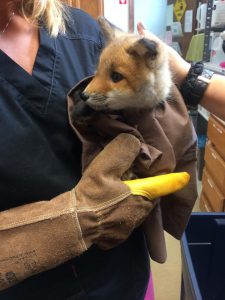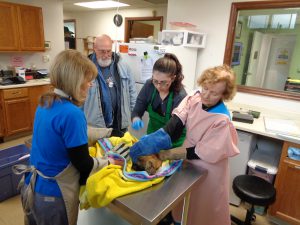 New grants awarded to Ohio Wildlife Center will be supporting Wildlife Hospital improvements, additional animal enclosures and red fox care.
New grants awarded to Ohio Wildlife Center will be supporting Wildlife Hospital improvements, additional animal enclosures and red fox care.
The Summerlee Foundation of Texas awarded a grant to Ohio Wildlife Center to support the rescue and rehabilitation of foxes with mange in Central Ohio. This project will add special caging at the Wildlife Hospital during acute care for mange, and add specially designed indoor and outdoor enclosures at the new Pre-Release Facility building for the final rehabilitation phase of mange foxes. Funds for specialized medications and nutrition are also part of the grant.
In 2018, Ohio Wildlife Center was the only organization in Central Ohio able to respond to a regional outbreak of mange disease in foxes across many suburban areas. The Wildlife Hospital assessed 34 foxes in 2018 for mange disease. Treatment requires extensive care and recovery time. The red foxes in the Columbus area were primarily affected by Sarcoptic mange, a mite that burrows through the skin causing intense irritation and itching that results in hair loss.
Left untreated, mange makes the foxes vulnerable to many secondary infections and complications. In cold weather the infected animals try to maintain body temperature by seeking warm places and death can be caused by starvation and hypothermia. Because foxes often share limited den space, the highly contagious disease spreads even faster.
“Rescues within the region of mange foxes after they are seen or found require Ohio Wildlife Center to dispatch the SCRAM! team to locate the den, set and monitor the traps daily and transport the animal to the Wildlife Hospital,” said Dusty Lombardi, executive director of Ohio Wildlife Center. “These costs can average hundreds of dollars in staff time that is provided by the Center to meet an urgent wildlife and community health situation,” she said.

For each mange fox assessed and treated, initial costs are $600 for veterinary care, vaccinations, medications and specialized nutrition. Each fox with the disease requires an average of two to three months of care over three phases of recovery so total rescue and rehabilitation costs can be considerable for each animal, Lombardi noted. Foxes are the largest carnivore Ohio Wildlife Center accepts.
“We are grateful the Summerlee Foundation has partnered with us to enable our staff and volunteers to provide optimum care in the best environment to ensure recovery for these foxes,” Lombardi said. “It’s ideal to have this transitional care during the required quarantine period with protected indoor and outdoor exercise pens for the foxes to regain muscle strength before release,” she added.
Wildlife Hospital to Remodel and Renovate
The All Life Foundation has awarded Ohio Wildlife Center a recent grant to construct additional outdoor mammal enclosures at the Pre-Release Facility and renovate the exam room and isolation ward at the Wildlife Hospital.
“The Wildlife Hospital continues to be the central engine serving the community with free patient care for injured, ill, orphaned and displaced wildlife,” said Lombardi. “With the patient volume steadily increasing each year as the public becomes more aware of the hospital, updates are needed to accommodate the greater numbers of patients,” she added.
During the busy season, up to 200 animals and 30 staff and volunteers may use the exam room space at the hospital every day. The isolation ward houses large patients still receiving medical treatment, or patients with infectious diseases. Examples of species using this room include Bald Eagles, owls, herons, fox, swans and bats.
“This ward is essential to provide space for the patients to move freely within the room outside of a cage, as they recover their flight, movement, and muscle function,” Lombardi noted. “Due to their level of injury or stage of infection, the animals in this ward are not ready to leave the hospital for the Pre-Release Facility as medication and feeding protocols still require continual management by veterinary staff,” she said. “The variety of species that the ward accommodates, from raptors to mammals, requires materials that can sustain rigorous use by both footed and flighted wildlife,” she said.
 New mammal enclosures at the Pre-Release Facility will accommodate the high numbers of mammals transitioning from the Wildlife Hospital to the PRF. Large mammals, such as raccoons and skunks, require special structures for their healthy defense mechanisms and behaviors while in care. In 2017, there were 289 raccoons and 69 striped skunks that recovered at the PRF. In 2018, there were 349 raccoons and 90 striped skunks.
New mammal enclosures at the Pre-Release Facility will accommodate the high numbers of mammals transitioning from the Wildlife Hospital to the PRF. Large mammals, such as raccoons and skunks, require special structures for their healthy defense mechanisms and behaviors while in care. In 2017, there were 289 raccoons and 69 striped skunks that recovered at the PRF. In 2018, there were 349 raccoons and 90 striped skunks.
The Ohio Division of Wildlife requires raccoons to be held for 60 days prior to release and that the raccoons receive three vaccinations during that time. It’s essential these enclosures provide space for the mammals to learn foraging and climbing behaviors, and have deterrents for digging, and protection from predators, Lombardi noted.
“These projects are important priorities for the Center in our wildlife rehabilitation and hospital care programs and we are grateful to the All Life Foundation for helping us meet the expanding needs in animal care and recovery,” Lombardi added.